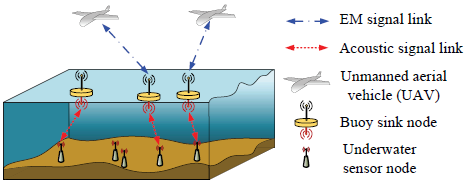On Connectivity of UAV-assisted Data Acquisition for Underwater Internet of Things
Abstract
Underwater exploration activities have grown significantly due to the proliferation of underwater Internet of Things (UIoT). However, to transmit sensor data from UIoT to remote onshore data processing center requires huge cost of deploying and maintaining communication infrastructures. In this paper, we propose an Unmanned Aerial Vehicles (UAVs)-assisted underwater data acquisition scheme by placing multiple sink nodes on the water surface to serve as intermediate relays between underwater sensors (IoT nodes) and UAVs. In our scheme, the sensor data is first transmitted via an acoustic-signal link to a buoyant sink node, which then forwards the data to a UAV via an electromagnetic link. In particular, we adopt two sink-node-deployment methods, i.e., grid placement and random placement of sink nodes. Since the path connectivity from an underwater sensor node to the UAV is crucial to guarantee reliable data acquisition tasks, we establish a theoretical framework to analyze the path connectivity via the intermediate sink node for both grid and random sink-node-deployment methods. Extensive simulation results validate the accuracy of the proposed analytical model. Moreover, our results also reveal the relationship between the path connectivity and other factors, such as sink node placements, antenna beamwidth of UAVs and wind speed. We also further extend our UAV-assisted data acquisition to other scenarios with consideration of trajectories of UAVs, movements of sink nodes, interference of both underwater acoustic and terrestrial radio links and integration with edge computing.
Keywords
- Underwater Internet of Things
- Unmanned Aerial Vehicles
- Connectivity
- Stochastic Geometry
Bibtex
@ARTICLE{QWang:IoTJ20,
author={Qubeijian Wang and Hong-Ning Dai and Qiu Wang and Mahendra K. Shukla and Wei Zhang and Carlos Guedes Soares},
journal={IEEE Internet of Things Journal},
title={On Connectivity of UAV-assisted Data Acquisition for Underwater Internet of Things},
year={2020},
volume={7},
number={6},
pages={5371 - 5385},
doi={10.1109/JIOT.2020.2979691},
}


Leave a Reply